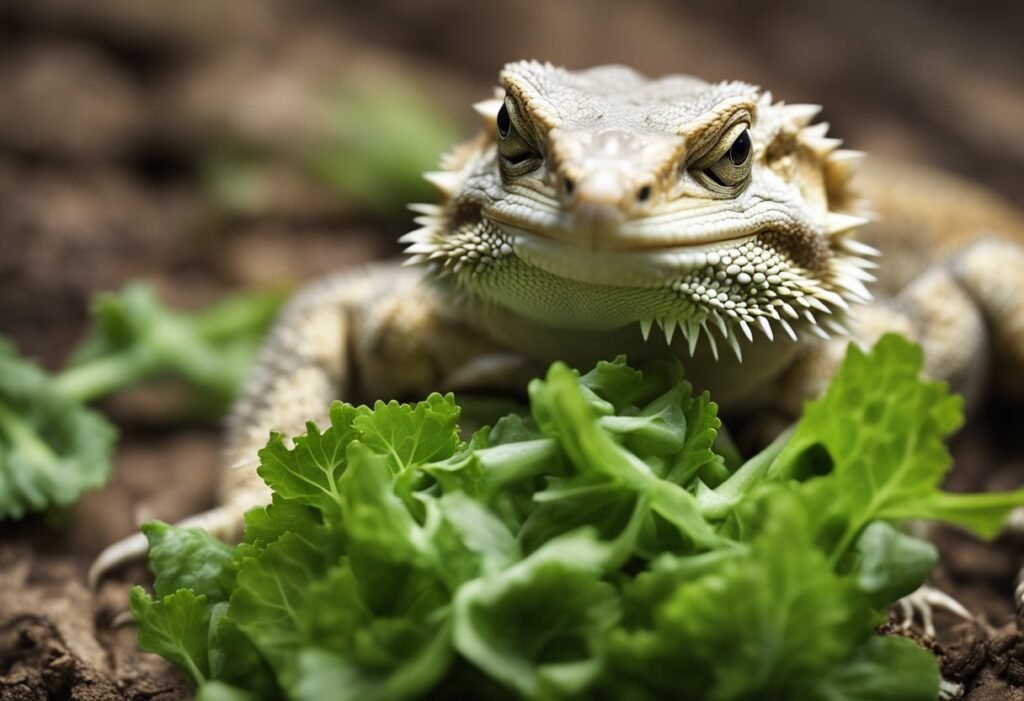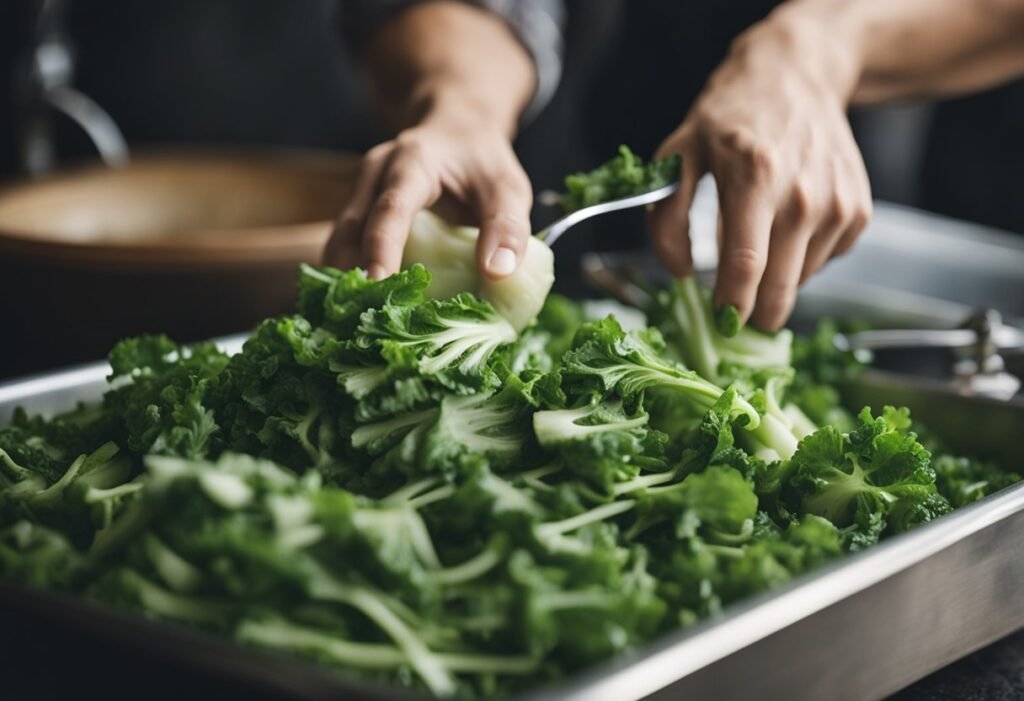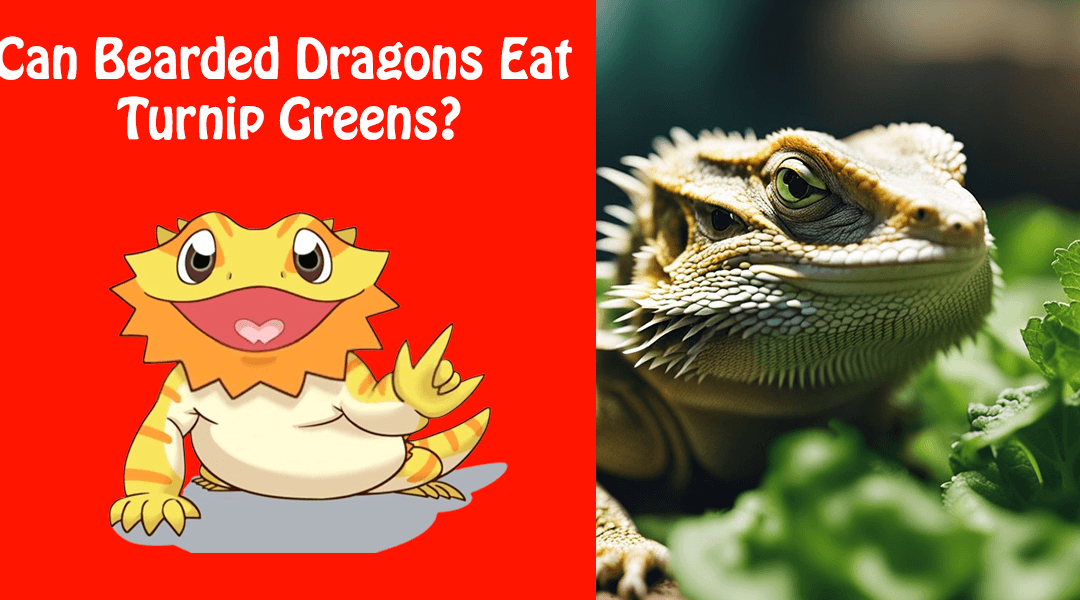Bearded dragons are known for their voracious appetite and their ability to eat a wide variety of foods. However, not all foods are safe for them to consume. One question that often arises is whether or not bearded dragons can eat turnip greens.
The answer is yes, bearded dragons can eat turnip greens. Turnip greens are a great source of nutrition for your bearded dragon and can be included as part of a balanced diet. They are low in oxalates, which can be harmful in large amounts, making them a safe choice for your pet.
When feeding turnip greens to your bearded dragon, it is important to ensure that they are fresh and have not been treated with any pesticides or chemicals. It is also important to feed them in moderation, as too much of any one type of food can upset your pet’s digestive system. With proper care and feeding, turnip greens can be a healthy addition to your bearded dragon’s diet.
Bearded Dragon Diet Basics

As responsible pet owners, we want to ensure that our bearded dragons are getting a well-balanced diet. A healthy diet for a bearded dragon consists of a variety of insects, vegetables, and fruits. In this section, we will focus on the vegetable portion of their diet.
When it comes to vegetables, turnip greens are a great option for bearded dragons. They are a good source of calcium, which is essential for healthy bones and egg-laying females. Turnip greens also contain other important nutrients such as vitamin A, vitamin C, and iron.
It is important to note that while turnip greens are a great addition to a bearded dragon’s diet, they should not be the sole vegetable offered. Bearded dragons require a variety of vegetables to ensure they are getting all the necessary nutrients. Some other vegetables that can be offered include collard greens, mustard greens, and kale.
When feeding vegetables, it is important to wash them thoroughly and chop them into small pieces to make it easier for the bearded dragon to eat. It is also important to avoid feeding them vegetables that are high in oxalates, such as spinach and beet greens, as they can interfere with calcium absorption.
In conclusion, turnip greens are a great addition to a bearded dragon’s diet, but should not be the only vegetable offered. A well-balanced diet consisting of a variety of vegetables, insects, and fruits is essential for their health and well-being.
Benefits of Turnip Greens for Bearded Dragons

Nutritional Value
Turnip greens are a great source of nutrition for bearded dragons. They are low in fat and calories, which makes them an excellent choice for maintaining a healthy weight. Turnip greens are also rich in vitamins and minerals, including calcium, vitamin A, vitamin C, and iron. These nutrients are essential for maintaining a healthy immune system, strong bones, and proper growth.
Health Advantages
In addition to their nutritional value, turnip greens offer several health benefits for bearded dragons. They are high in fiber, which helps promote healthy digestion and prevents constipation. Turnip greens also contain antioxidants that help protect against cellular damage and reduce the risk of certain diseases. Furthermore, the calcium in turnip greens is essential for maintaining strong bones and preventing metabolic bone disease.
Overall, turnip greens are a nutritious and healthy addition to a bearded dragon’s diet. They provide essential vitamins and minerals, promote healthy digestion, and offer several health benefits. However, it’s important to remember that turnip greens should be fed in moderation and as part of a balanced diet that includes a variety of other vegetables and protein sources.
How to Prepare Turnip Greens for Bearded Dragons

Washing and Chopping
When preparing turnip greens for your bearded dragon, it is important to wash them thoroughly to remove any dirt or pesticides. We recommend rinsing them under cool running water and using a vegetable brush to gently scrub the leaves. After washing, pat them dry with a paper towel or let them air dry.
Next, it’s time to chop the turnip greens into small, bite-sized pieces. This will make it easier for your bearded dragon to eat and digest. We suggest using a sharp knife or kitchen scissors to chop the greens into small pieces.
Serving Size and Frequency
When it comes to serving size, it’s important to remember that turnip greens should only make up a small portion of your bearded dragon’s diet. We recommend offering turnip greens as a treat or supplement, rather than a main source of nutrition.
For adult bearded dragons, a serving size of turnip greens should be about the size of their head, offered once or twice a week. For baby bearded dragons, a smaller serving size should be offered once a week.
It’s important to note that turnip greens contain high levels of calcium oxalates, which can bind to calcium and prevent its absorption. To avoid this, we recommend rotating turnip greens with other leafy greens that have lower levels of calcium oxalates, such as collard greens or mustard greens.
Overall, turnip greens can be a healthy and nutritious addition to your bearded dragon’s diet when prepared and served correctly.
Potential Risks of Feeding Turnip Greens
When considering feeding turnip greens to a bearded dragon, it is important to be aware of the potential risks associated with this vegetable. While turnip greens can provide some nutritional benefits, they also contain certain compounds that can be harmful to your pet if consumed in excess.
Oxalates and Goitrogens
One of the main concerns with feeding turnip greens to bearded dragons is the presence of oxalates and goitrogens. Oxalates are compounds that can bind to calcium in the body, potentially leading to the formation of kidney stones and other health issues. Goitrogens, on the other hand, can interfere with thyroid function and lead to goiter formation.
While small amounts of these compounds are generally not harmful, feeding large quantities of turnip greens on a regular basis could increase the risk of health problems. It is important to vary your bearded dragon’s diet and not rely solely on turnip greens as a source of nutrition.
Calcium to Phosphorus Ratio
Another potential issue with feeding turnip greens to bearded dragons is the calcium to phosphorus ratio. Turnip greens contain a high amount of phosphorus relative to calcium, which can lead to a calcium deficiency if fed in excess.
To avoid this issue, it is important to balance your bearded dragon’s diet with other calcium-rich foods such as calcium supplements, leafy greens, and calcium-rich fruits. Additionally, it is important to limit the amount of turnip greens you feed your pet to avoid an imbalance in the calcium to phosphorus ratio.
In conclusion, while turnip greens can provide some nutritional benefits to your bearded dragon, they should be fed in moderation and as part of a balanced diet. Be sure to monitor your pet’s health and adjust their diet accordingly to ensure they are receiving all the nutrients they need to thrive.
Incorporating Turnip Greens into a Balanced Diet
As pet owners, we want to ensure that our bearded dragons receive a balanced and nutritious diet. Turnip greens are a great addition to their diet as they provide a variety of nutrients.
One of the benefits of turnip greens is their high calcium content. Calcium is crucial for bearded dragons as it helps maintain strong bones and prevents metabolic bone disease. Turnip greens also contain vitamin A, which is essential for maintaining healthy eyesight and a strong immune system.
To incorporate turnip greens into our bearded dragon’s diet, we can offer them as a staple food item or as part of a varied diet. We can mix turnip greens with other leafy greens such as collard greens, kale, or mustard greens to provide a diverse range of nutrients.
It’s important to note that turnip greens contain goitrogens, which can interfere with thyroid function if consumed in large amounts. To avoid this, we should offer turnip greens in moderation and rotate them with other leafy greens.
In summary, turnip greens are a nutritious addition to our bearded dragon’s diet. By incorporating them into a balanced and varied diet, we can ensure that our pets receive the necessary nutrients for optimal health.
Alternatives to Turnip Greens

While turnip greens are a great source of nutrition for bearded dragons, there are other greens that can be added to their diet to provide variety and balance. Here are some alternatives to turnip greens that you can consider:
Collard Greens
Collard greens are a great alternative to turnip greens as they are rich in calcium, fiber, and vitamins A and C. They are also low in oxalates, which can interfere with calcium absorption. You can offer collard greens to your bearded dragon raw or cooked.
Mustard Greens
Mustard greens are another great option for bearded dragons as they are high in calcium, fiber, and vitamins A and C. They are also low in oxalates. Mustard greens have a slightly bitter taste, so your bearded dragon may need some time to adjust to them.
Dandelion Greens
Dandelion greens are a nutritious addition to your bearded dragon’s diet as they are high in calcium, fiber, and vitamins A and C. They are also low in oxalates. You can offer dandelion greens to your bearded dragon raw or cooked.
Endive
Endive is a great source of nutrition for bearded dragons as it is high in fiber, calcium, and vitamins A and C. It is also low in oxalates. Endive has a slightly bitter taste, so your bearded dragon may need some time to adjust to it.
Escarole
Escarole is another great option for bearded dragons as it is high in fiber, calcium, and vitamins A and C. It is also low in oxalates. Escarole has a slightly bitter taste, so your bearded dragon may need some time to adjust to it.
Remember to always offer a variety of greens to your bearded dragon to ensure they are getting a balanced diet. Rotate the greens you offer to provide variety and avoid overfeeding any one type of green.
Frequently Asked Questions
What are the best leafy greens to include in a bearded dragon’s diet?
Leafy greens are an essential part of a bearded dragon’s diet. Some of the best options include collard greens, kale, and mustard greens. These greens are high in calcium and other essential nutrients that help keep your bearded dragon healthy.
How often can mustard greens be safely fed to a bearded dragon?
Mustard greens can be fed to your bearded dragon every day, but it’s important to ensure that they are not the only greens in their diet. Variety is key, so it’s best to switch up the greens you offer your bearded dragon to ensure they are getting a balanced diet.
Are collard greens a suitable daily food for bearded dragons?
Collard greens are a great option to include in your bearded dragon’s daily diet. They are high in calcium and other essential nutrients, making them a healthy choice for your pet.
Which vegetables should be avoided due to toxicity in bearded dragons?
Some vegetables, such as spinach and rhubarb, should be avoided due to their high oxalate content, which can lead to kidney problems in bearded dragons. Additionally, avocado and onion should be avoided as they are toxic to bearded dragons.
Can I offer green beans to my bearded dragon, and if so, how frequently?
Green beans can be offered to your bearded dragon in moderation. They are not as nutritionally dense as leafy greens, but can be a good addition to their diet. It’s recommended to offer green beans once or twice a week.
What variety of fruits and vegetables can bearded dragons consume for a balanced diet?
In addition to leafy greens, bearded dragons can also consume a variety of fruits and vegetables. Some good options include squash, carrots, bell peppers, and berries. It’s important to offer a variety of foods to ensure your bearded dragon is getting all the nutrients they need.
I, Mark Antonelli am highly interested in pet care tips. The experiences I gained through university life in animal sciences were also helpful to identify the best tricks for caring for and feeding varying kinds of pets. I know the majority of people love to own a pet. Yet, there is a guilty of owing a Bearded Dragon due to a lack of information about how much friendly and peaceful they are. I thought of filling this gap with detailed writings about this Pogona genus Bearded Dragon. All my team is also giving me great support to fulfil my mission. Hope you will enjoy the journey with us.

